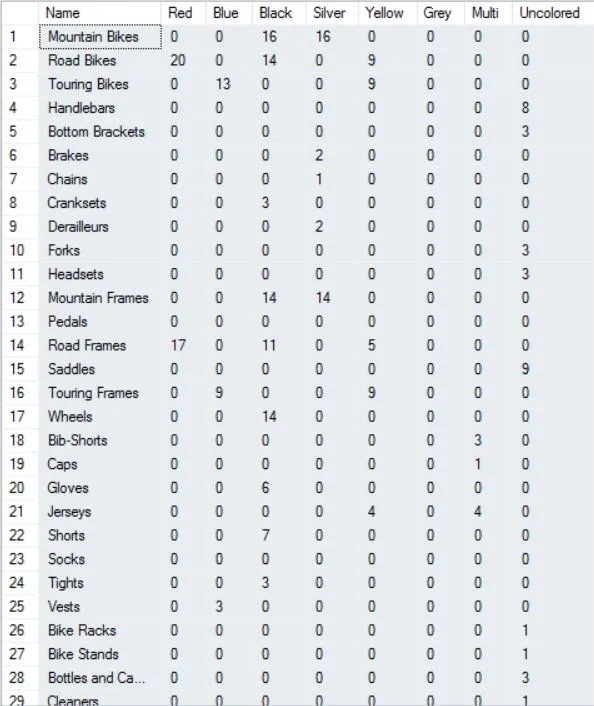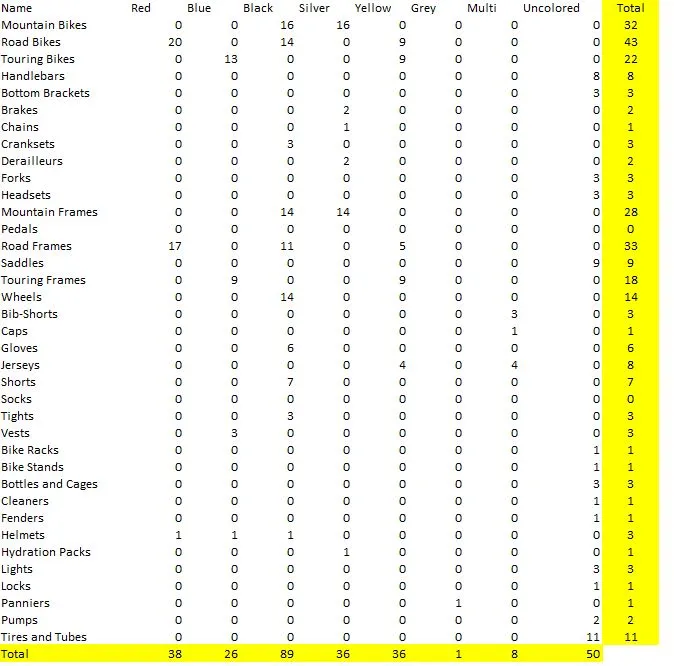你可以在这里找到类似问题:
在 SQL Server 2008 中使用带有列和行总计的数据透视表
使用 CUBE,一个解决方案可能是
WITH SalesLT_ProductCategory as (
SELECT * FROM (
VALUES
(1, 'Mountain Bikes'),
(2, 'Road Bikes'),
(3, 'Touring Bikes'),
(4, 'Brakes')
) AS a (ProductCategoryID, Name)
), SalesLT_Product AS (
SELECT * FROM (
VALUES
(1, 1, 'Red'),
(1, 1, 'Blue'),
(1, 1, 'Blue'),
(1, 1, 'Blue'),
(1, 2, 'Red'),
(1, 2, 'Red'),
(1, 2, 'Blue'),
(1, 2, 'Black'),
(1, 3, 'Black'),
(1, 3, 'Yellow'),
(1, 3, 'Grey'),
(1, 3, 'Grey'),
(1, 3, 'Grey'),
(1, 4, 'Red'),
(1, 4, 'Multi'),
(1, 4, 'Multi'),
(1, 4, 'Uncolored'),
(1, 4, 'Uncolored'),
(1, 4, 'Uncolored')
) AS a (ProductID, ProductCategoryID, Color)
), BaseData AS (
SELECT p.ProductID, pc.Name, ISNULL(p.Color, 'Uncolored') AS Color
FROM SalesLT_ProductCategory AS pc
INNER JOIN SalesLT_Product AS p ON pc.ProductCategoryID = p.ProductCategoryID
)
SELECT
Name,
COALESCE(Red, 0) AS Red,
COALESCE(Blue, 0) AS Blue,
COALESCE(Black, 0) AS Black,
COALESCE(Silver, 0) AS Silver,
COALESCE(Yellow, 0) AS Yellow,
COALESCE(Grey, 0) AS Grey,
COALESCE(Multi, 0) AS Multi,
COALESCE(Uncoloured, 0) AS Uncoloured,
Total
FROM (
SELECT
COALESCE(Name, 'Total') AS Name,
COALESCE(Color, 'Total') AS Color,
COUNT(*) AS Count
FROM BaseData
GROUP BY CUBE (Name, Color)
) AS t
PIVOT (
SUM(Count) FOR Color IN (
Red, Blue, Black, Silver, Yellow,
Grey, Multi, Uncoloured, Total
)
) AS p
ORDER BY CASE Name WHEN 'Total' THEN 1 ELSE 0 END, Name
使用CTE,另一种解决方案可能是
WITH SalesLT_ProductCategory as (
SELECT * FROM (
VALUES
(1, 'Mountain Bikes'),
(2, 'Road Bikes'),
(3, 'Touring Bikes'),
(4, 'Brakes')
) AS a (ProductCategoryID, Name)
), SalesLT_Product as (
SELECT * FROM (
VALUES
(1, 1, 'Red'),
(1, 1, 'Blue'),
(1, 1, 'Blue'),
(1, 1, 'Blue'),
(1, 2, 'Red'),
(1, 2, 'Red'),
(1, 2, 'Blue'),
(1, 2, 'Black'),
(1, 3, 'Black'),
(1, 3, 'Yellow'),
(1, 3, 'Grey'),
(1, 3, 'Grey'),
(1, 3, 'Grey'),
(1, 4, 'Red'),
(1, 4, 'Multi'),
(1, 4, 'Multi'),
(1, 4, 'Uncolored'),
(1, 4, 'Uncolored'),
(1, 4, 'Uncolored')
) AS a (ProductID, ProductCategoryID, Color)
), PivotData AS (
SELECT *
FROM
(
SELECT p.ProductID, pc.Name, ISNULL(p.Color, 'Uncolored') AS Color
FROM SalesLT_ProductCategory AS pc
INNER JOIN SalesLT_Product AS p ON pc.ProductCategoryID = p.ProductCategoryID
)
AS PPC
PIVOT (COUNT(ProductID) FOR COLOR IN ([Red], [Blue], [Black], [Silver], [Yellow], [Grey], [Multi], [Uncolored]))
AS ColorPivotTable
), ColumnTotals AS (
SELECT
'Total' AS Name
, SUM(Red) AS Red
, SUM(Blue) AS Blue
, SUM(Black) AS Black
, SUM(Silver) AS Silver
, SUM(Yellow) AS Yellow
, SUM(Grey) AS Grey
, SUM(Multi) AS Multi
, SUM(Uncolored )AS Uncolored
FROM PivotData
), PivotDataWithRowTotals AS (
SELECT * FROM PivotData
UNION ALL
SELECT * FROM ColumnTotals
)
SELECT P.*
, P.Red + P.Blue + P.Black + P.Silver + P.Yellow + P.Grey + P.Multi + P.Uncolored as Total
FROM PivotDataWithRowTotals AS P

 非常感谢您提前的任何反馈。
非常感谢您提前的任何反馈。